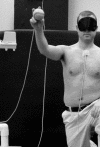Functional Fatigue Decreases 3-Dimensional Multijoint Position Reproduction Acuity in the Overhead-Throwing Athlete
- PMID: 15592603
- PMCID: PMC535523
Functional Fatigue Decreases 3-Dimensional Multijoint Position Reproduction Acuity in the Overhead-Throwing Athlete
Abstract
OBJECTIVE: To determine the effects of functional fatigue on active multijoint position reproduction in overhead-throwing athletes. DESIGN AND SETTING: A standard, repeated-measures, randomized-ordered, counterbalanced, 2-period (crossover) design was used. During the first test session, we randomly assigned subjects to either the nonfatigue or fatigue condition. Subjects underwent pretest measurements and then either a functional fatigue protocol or rest period, followed by posttest measurements. After a recovery period, subjects crossed over to the opposing condition for the second testing session. SUBJECTS: Thirteen overhead-throwing athletes competing in National Collegiate Athletic Association Division I or club baseball, with no history of upper extremity or central nervous system disorders, volunteered for this study. MEASUREMENTS: We measured active multijoint position reproduction accuracy in 3 dimensions using an electromagnetic tracking device. We noted each subject's ability to reproduce 3 positions corresponding with distinct moments of his throwing motion. A variable error score was calculated to compare the locations of the reproduced points with reference to the target point. RESULTS: A significant difference occurred between the pretest and posttest error scores in the fatigue condition. Comparisons between positions indicated that more errors were seen in the arm-cocked position than in the follow-through position under both fatigue and nonfatigue conditions. CONCLUSIONS: Functional fatigue decreased joint position sense acuity in overhead-throwing athletes. Our findings using this novel testing measurement method are in agreement with past research, with one exception. The trend toward higher error scores in the arm-cocked position would appear to contradict findings that sensorimotor system acuity increases toward end ranges of motion.
Figures



References
-
- Lephart SM, Riemann BL, Fu FH. Champaign, IL: Human Kinetics; 2000. Proprioception and Neuromuscular Control in Joint Stability.
-
- Chen SK, Simonian PT, Wickiewicz TL, Otis JC, Warren RF. Radiographic evaluation of glenohumeral kinematics: a muscle fatigue model. J Shoulder Elbow Surg. 1999;8:49–52. - PubMed
-
- Safran MR, Borsa PA, Lephart SM, Fu FH, Warner JJ. Shoulder proprioception in baseball pitchers. J Shoulder Elbow Surg. 2001;10:438–444. - PubMed
-
- Lephart SM, Pincivero DM, Giraldo JL, Fu FH. The role of proprioception in the management and rehabilitation of athletic injuries. Am J Sports Med. 1997;25:130–137. - PubMed
-
- Voight ML, Hardin JA, Blackburn TA, Tippett S, Canner GC. The effects of muscle fatigue on and the relationship of arm dominance to shoulder proprioception. J Orthop Sports Phys Ther. 1996;23:348–352. - PubMed
LinkOut - more resources
Full Text Sources
Miscellaneous
